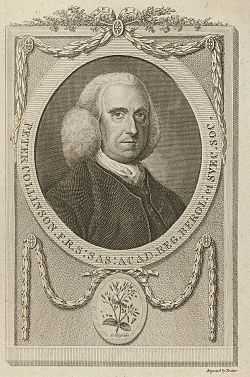1755 in paleontology
| List of years in paleontology |
|---|
| ... 1745 . 1746 . 1747 . 1748 . 1749 . 1750 . 1751 ... 1752 1753 1754 -1755- 1756 1757 1758 ... 1759 . 1760 . 1761 . 1762 . 1763 . 1764 . 1765 ... In science: 1752 1753 1754 -1755- 1756 1757 1758 |
| Art . Archaeology . Architecture . Literature . Music . Philosophy . Science +... |
Paleontology, palaeontology or palæontology (from Greek: paleo, "ancient"; ontos, "being"; and logos, "knowledge") is the study of prehistoric life forms on Earth through the examination of plant and animal fossils.[1] This includes the study of body fossils, tracks (ichnites), burrows, cast-off parts, fossilised feces (coprolites), palynomorphs and chemical residues. Because mankind has encountered fossils for millennia, paleontology has a long history both before and after becoming formalized as a science. This article records significant discoveries and events related to paleontology that occurred or were published in the year 1755.
Fossils

Peter Collinson
- Joshua Platt, a dealer in curiosities, discovers three large dinosaurian vertebrae at Stonesfield. He sends them off for examination to a Quaker botanist, merchant, and friend of Benjamin Franklin named Peter Collinson. Sadly, Collinson never gives them Platt's desired examination, and the fate and specific identity of the fossils remain unknown.[2]
References
- ↑ Gini-Newman, Garfield; Graham, Elizabeth (2001). Echoes from the past: world history to the 16th century. Toronto: McGraw-Hill Ryerson Ltd. ISBN 9780070887398. OCLC 46769716.
- ↑ Farlow, James O.; M. K. Brett-Surmann (1999). The Complete Dinosaur. Bloomington, Indiana: Indiana University Press. p. 5. ISBN 0-253-21313-4.